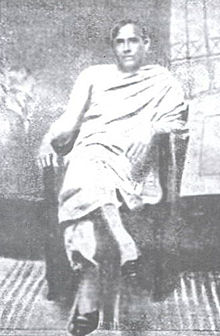
Sri Yukteswar Giri is the monastic name of Priya Nath Karar, an Indian monk and yogi, and the guru of Paramahansa Yogananda and Swami Satyananda Giri. Born in Serampore, West Bengal, Sri Yukteswar was a Kriya yogi, a Jyotisha, a scholar of the Bhagavad Gita and the Upanishads, an educator, author, and astronomer. He was a disciple of Lahiri Mahasaya of Varanasi and a member of the Giri branch of the Swami order. As a guru, he had two ashrams, one in Serampore and another in Puri, Odisha, between which he alternated his residence throughout the year as he trained disciples.

Bardhaman, officially Bardhaman Sadar, is a city and municipality in the state of West Bengal, India. It is the headquarters of Purba Bardhaman district, having become a district capital during the period of British rule. Burdwan, an alternative name for the city, has remained in use since then.

Bagha Jatin or Baghajatin, born Jatindranath Mukherjee ; 7 December 1879 – 10 September 1915) was an Indian independence activist.
Prajnanapada, popularly known as Swami Prajnanapada or Swami Prajnanpad (1891–1974) of Channa Ashram, was one of the eminent disciples of Niralamba Swami, the great yogi and Guru of India. He was born on 8 February 1891. He entered the life of Sannyasa and became Niralamba Swami’s disciple in 1924-25 at Channa ashram. Besides living at Channa Ashram, he had also established an ashram in Ranchi, India.

Katwa is a sub-divisional town and railway junction in Purba Bardhaman district of the Indian state of West Bengal. It is the headquarters of the Katwa subdivision. The town was built at the confluence of Ganga and Ajay. Katwa is a border city of three districts; Purba Bardhaman District, Nadia District and Murshidabad District.
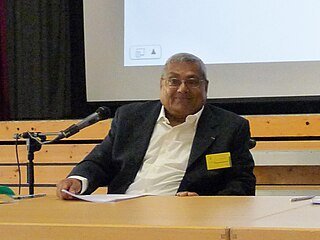
Prithwindra Mukherjee, who retired in 2003 from his career as a researcher in the Human and Social Sciences Department (Ethnomusicology) of the French National Centre of Scientific Research in Paris, is an author of a number of books and other publications on various subjects.

Rarh region is a toponym for an area in the Indian subcontinent that lies between the Chota Nagpur Plateau on the West and the Ganges Delta on the East. Although the boundaries of the region have been defined differently according to various sources throughout history, it is mainly coextensive with the state of West Bengal, also comprising parts of the state of Jharkhand in India. Linguistically, the region is defined with population speaking the Rarhi Bengali local Bengali dialect.
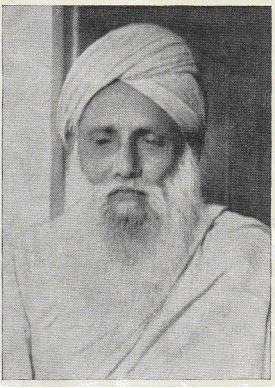
Bhavabhushan Mitra, or Bhaba Bhusan Mitter, alias Swami Satyananda Puri was a Bengali Indian freedom fighter and an influential social worker.
Pandit Mokshada Charan Samadhyayi (1874–?) was a leading figure of the Jugantar movement.

Amarendranath Chatterjee was an Indian independence movement activist. In charge of raising funds for the Jugantar movement, his activities largely covered revolutionary centres in Bihar, Odisha and the United Provinces.
Sri Anirvan, born Narendra Chandra Dhar, was an Indian Hindu monk, writer and philosopher. Widely known as a scholar, his principal works were a Bengali translation of Sri Aurobindo's The Life Divine and the three-volume treatise Veda Mimamsa.
Palitpur is a village in Burdwan I CD Block in Bardhaman Sadar North subdivision of Purba Bardhaman district in West Bengal, India. It is famous for the ashram and samādhi (tomb) of Tibbetibaba, a famous saint.
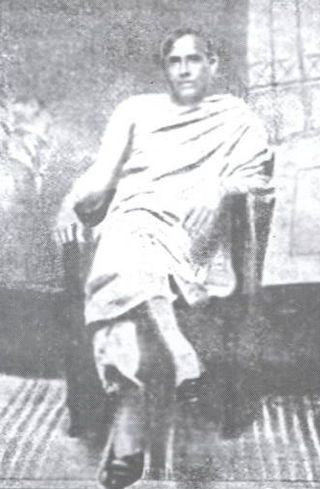
Jatindra Nath Banerjee was one of two great Indian nationalists and freedom fighters – along with Aurobindo Ghosh – who dramatically rose to prominence between 1871 and 1910.
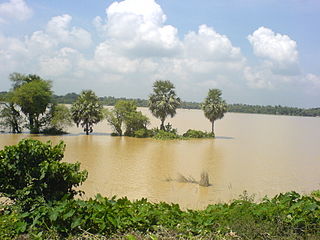
Burdwan II is a community development block that forms an administrative division in Bardhaman Sadar North subdivision of Purba Bardhaman district in the Indian state of West Bengal.
The Rodda company arms heist took place on 26 August 1914 in Calcutta, British India. Members of the Jugantar faction of the Bengali revolutionary organisation Anushilan Samiti intercepted a shipment of Mauser Pistols and ammunition belonging to Messrs Rodda & co., a Calcutta gun dealer, while these were en route from the Customs house to the company's godown, and were able to make away with a portion the arms. The heist was a sensational incident, being described by The Statesman as the "Greatest daylight robbery". In the following years, the pistols and ammunitions were linked to almost all the incidences of nationalist struggles in Bengal. By 1922, the police had recovered most of the stolen arms.
Shyamsundar is a village in Raina I CD block in Bardhaman Sadar South subdivision of Purba Bardhaman district in the state of West Bengal, India.
Mankar is a village in Galsi I CD Block in Bardhaman Sadar North subdivision of Purba Bardhaman district in the state of West Bengal, India.
Hatgobindapur is a village in Burdwan II CD block in Bardhaman Sadar North subdivision of Purba Bardhaman district in the state of West Bengal, India.

Purba Bardhaman district is in the Indian state of West Bengal. Its headquarters is in Bardhaman. It was formed on 7 April 2017 after the division of the previous Bardhaman district. Great revolutionary Rash Behari Bose was born in village Subaldaha in the district of Purba Bardhaman.

Gopbhum or Gopbhumi is a historical region of West Bengal state in Eastern India. It included the entire area between the Ajay and Damodar rivers, which is present-day Purba Bardhaman, Birbhum, Jamtara, Purulia and Paschim Bardhaman districts of West Bengal. English translation of the word 'Gopbhum' is 'The land of Gopa'.



